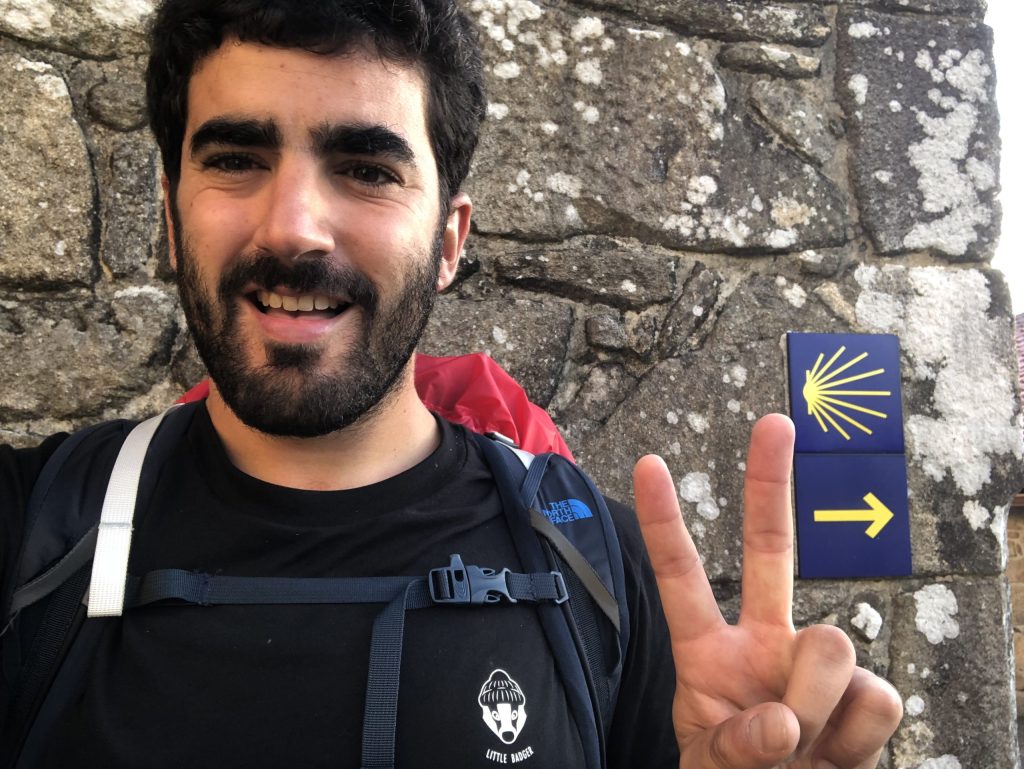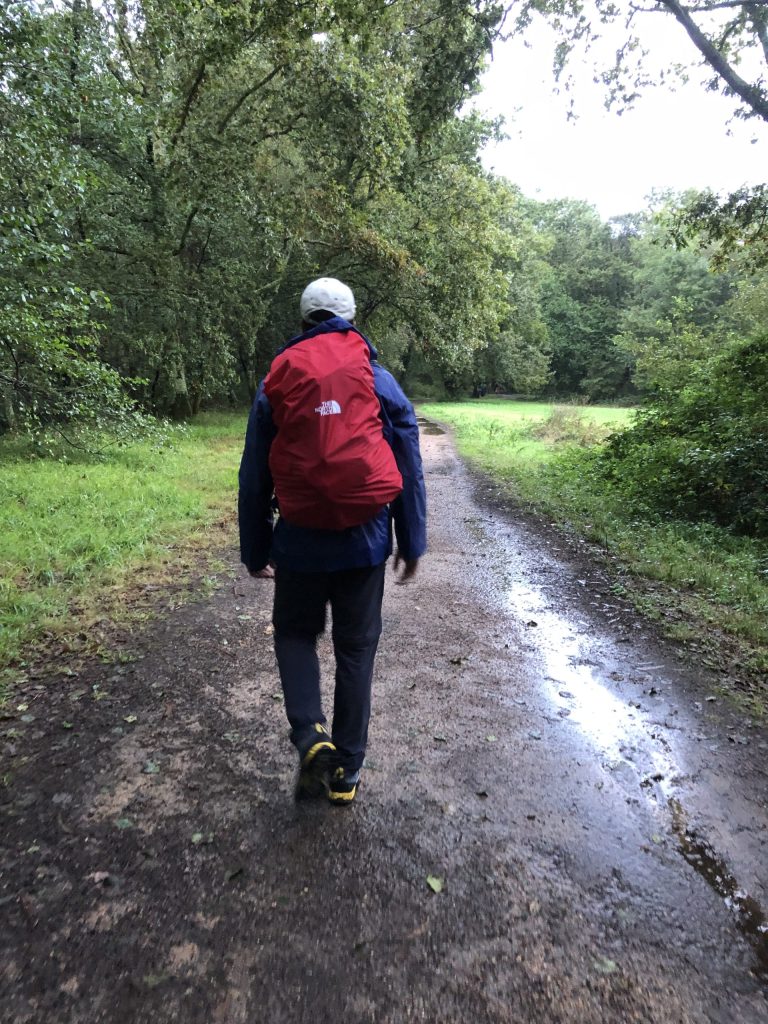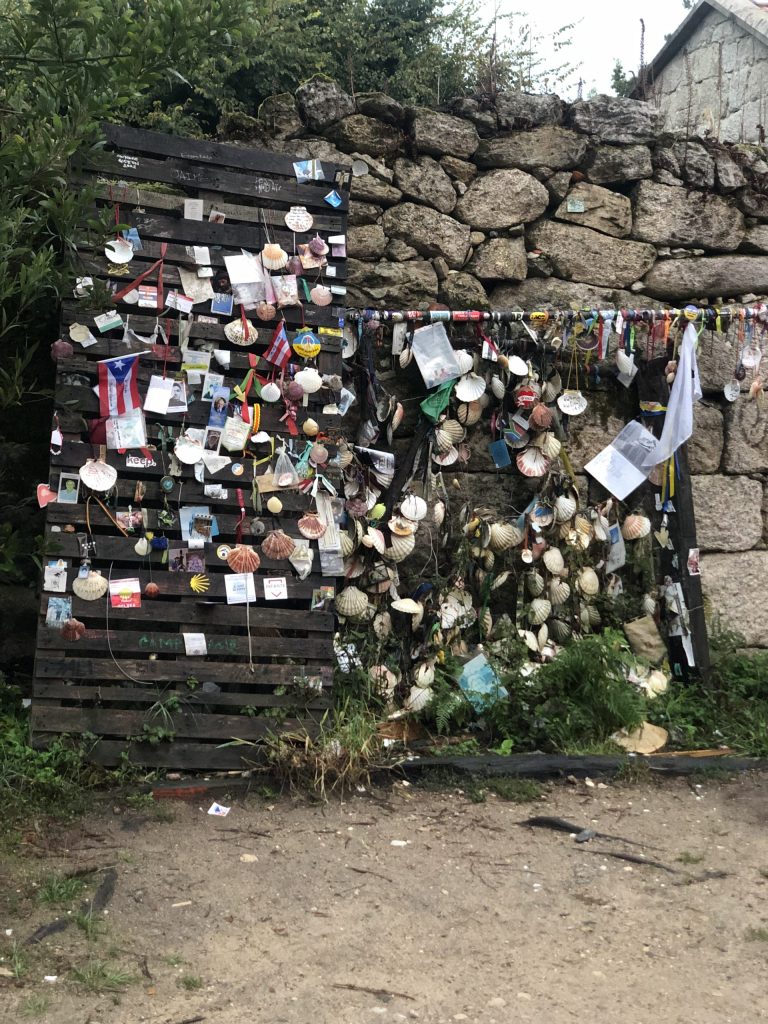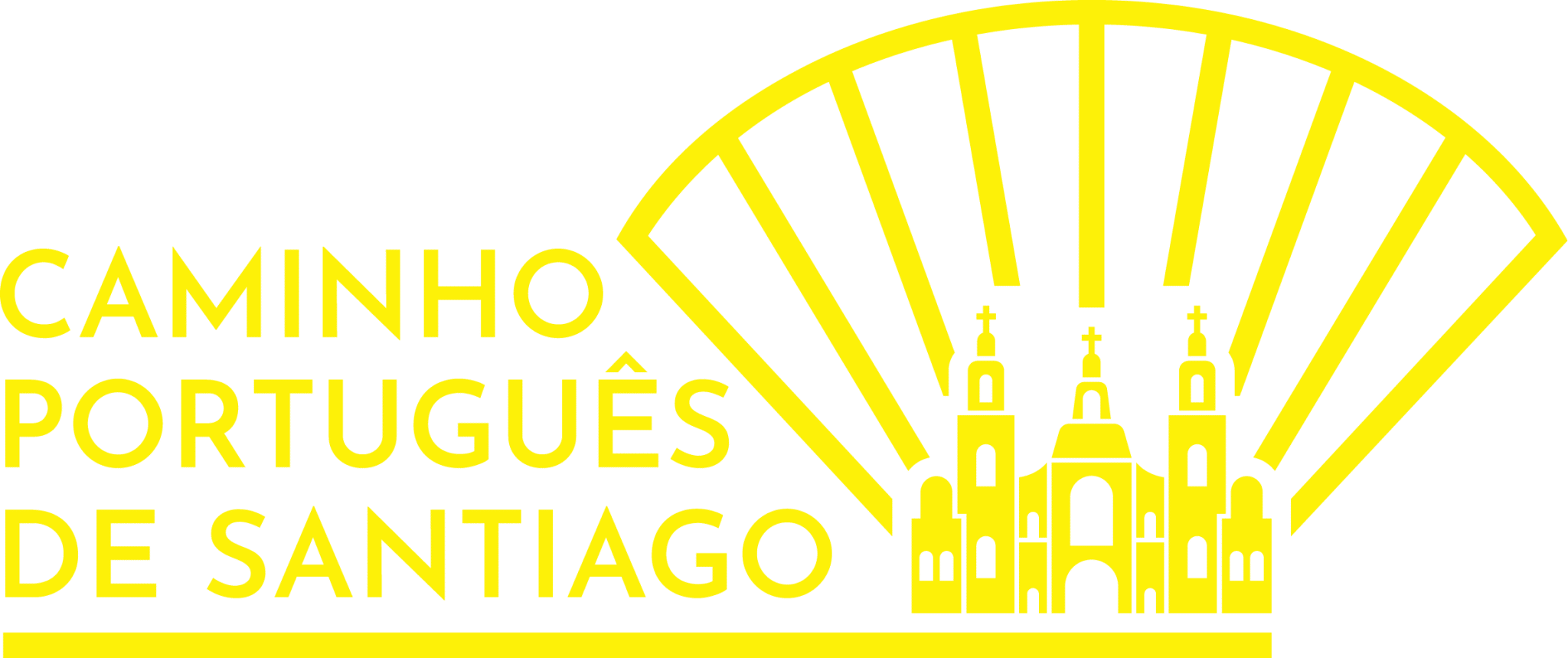Ricardo knows better than anyone that the Way to Santiago calls for pilgrims. In this way, the millennial route has always hovered around him. So when he was challenged to do it, the yes was immediate, as if the decision had already been made well before that moment. Read this entertaining interview that will help you prepare your own trail to the Capital of Galicia.
Why did you do the Way to Santiago?
Ricardo: The Way to Santiago has always been something that has gravitated around my life, particularly in my late teens and early adulthood. I grew up in a religious, Catholic family.
The topics of pilgrimages and questions of faith were always a topic discussed at home. In addition, I was also part of a group of young people who, with a certain frequency, walked stages/stretches of the Way during their Easter vacations, events in which I never had the opportunity to participate, although I had a natural interest.
My parents went on pilgrimage to Fatima several times, but I confess it was never something that called to me. There was no vocation urging me to go to the Cova da Iria. As for Santiago, the panorama is way different.
I have a family friend who has completed the Way many times, starting from many different points, with various lengths and miles traveled – he has even written a book about the Way to Santiago.
The experiences I narrated, along with testimonies of my friends, planted the seed of desire to discover the spirituality that motivates thousands of people to take a backpack and a staff, cover themselves with scallops and yellow arrows and set out on foot to a place where, curiously enough, I had been many times before. But the culmination of this discovery, of the need to go on pilgrimage to Santiago, was when my brother returned home after making the trip himself. The feeling he described to me was the flame that gave breath to my will. When my girlfriend suggested that we go on the road, my yes escaped me before my mouth even moved.

How many days did it take?
Ricardo: In order to fit the path into our daily lives, we scheduled a 5-day pilgrimage to achieve the goal of experiencing the path without rushing and hurrying.
Which stages did you complete?
Ricardo: We chose to do the Portuguese route because it was the most familiar and the one we had the most feedback and stories about from other people – friends and family, as well as proximity.
Since one of the secondary objectives was to get to Compostela, we decided, in a very unoriginal idea, to start from Tui. The division was made taking into account the number of days in which we would like to complete the journey, as well as the kilometers covered at each stage.
The plan was first to do the Tui – Redondela section, about 33 kilometers (a few more, as we made some detours from the “original” route, avoiding, for example, the long straight line in the industrial zone of O Porriño); then the Redondela – Pontevedra section, approximately 20 kilometers; Pontevedra – Caldas de Reis, 22 kilometers; Caldas de Reis – Padrón, 19 kilometers and, finally, Padrón – Santiago de Compostela, 24 kilometers.
What was the best meal you had on the way?
Ricardo: This question is very easy to answer: between Pontevedra and Caldas de Reis there is a village called Barro. There are some beautiful waterfalls near the N550 called Fervenzas do Barosa. Just before you get to these waterfalls, on the road, there is a house that has converted a garage into a stopping place for pilgrims. It is called Furancho A Seca or Furancho da Barosa. It is a stopping point that should be in the library archives of the Cathedral of Santiago!
More seriously, it’s a place to socialize and relax where you can enjoy Galician gastronomy at its best – empanada, octopus, chorizos and sausages, all available on a large table. All you have to do is choose, eat, enjoy, and at the end just tell the friendly innkeepers what you’ve eaten, and you’ll always be rewarded with a big smile. But the real relic is Alvarinho, the wine sipped in a bowl. It’s so good that you can leave aside the ointments and the painkillers because nothing heals better than wine.
This stop is a given to all pilgrims.
How did you prepare yourself physically for the journey?
Ricardo: There was not exactly a physical plan to face the Way. Fortunately I don’t suffer from any major physical ailments and I exercise regularly, so I felt prepared for the redoubled physical effort that lay ahead. I know people who do the walkways in Vila Nova de Gaia – about 15km – as preparation, but I didn’t think it was necessary to draw up any special plan to prepare myself physically.

What surprised you the most on the journey?
Ricardo: How much GREEN color there is in Galicia. That area is absolutely magical, with the hills and woods painted this color, which convey a sense of peace and serenity. The perfect security we felt is also very comforting – at no time did we feel afraid that something bad could happen to us. The relaxed and even cheerful way in which the locals regarded us was also a very positive point.
What was your most challenging moment?
Ricardo: I think this question can be answered from the physical side and psychological side.
As far as the first one is concerned, I think the biggest physical challenge was the end of our first section Tui – Redondela. In hindsight, it was perhaps the only thing I would rectify. I think we either broke up the stage and stopped in O Porriño or we slowed the pace. The climb after the village of Rúa (Mos), reaching the chapel of Santiaguiño do Monte and the steep descent to the road that takes us to Redondela were, without a doubt, the hardest on the legs (and in the spirit, too). Fortunately, the hostel where we stayed was right at the entrance to Redondela – I say fortunately because our legs were literally shaking and weak when we got there.
Psychologically, I think the last few kilometers of the arrival in Santiago are a test of any pilgrim’s patience. When you reach the town of O Milladoiro and finally glimpse at the Cathedral of Santiago, your heart beats with anxiety and excitement to see how close you are! When we looked at the map, there were about 7/8 km to go before we reached the finish line… A small distance for those who already have a hundred kilometers on their legs. However, it is in those same kilometers that cost the most. Seeing milestone after milestone with arrows at each micro crossing, with those numbers that don’t seem to change, as if time doesn’t pass. More than an hour passed since we saw the Cathedral and it seems as if we are going backwards; that we are walking backwards or in the wrong direction, if it weren’t for our fellow marchers that we saw everywhere, at the confluence of various paths. But it’s all worth it, because the road is crossed by walking and the arrival in Santiago makes up for – and how well it does! – the tribulations.
Who did you meet along the way that you will never forget?
Ricardo: Honestly, I don’t know if it was the time of year or our schedule or pace when walking, but there weren’t many pilgrims or groups that left an indelible mark. Naturally we recognized “familiar” faces along the way, people who passed us or whom we saw resting a little further ahead, as if they were some kind of landmarks of the path itself. Perhaps I would highlight four people or groups of people:
The first person was the one we shared a room with in Tui. She was a New Zealander who was walking the Way with her parents, now septuagenarians, and who made a point of taking several days off every year to do the Way. The strength of her will, her availability, and her desire to repeat and live the experience of the path were a good driving force for the days that followed.
The second character appeared on a brief episode, but one that marked a turning point. When we arrived in Pontevedra, my girlfriend already had complaints about her feet and seemed to be a bit discouraged (which was not true, in her words). So we went looking for a pharmacy or shoe store that sold insoles for the boots. We ended up in a store that sold items for walking.
There was a young Italian woman trying on some sandals, and when we looked at her feet, they were covered with bandages and pads. The lady in the store told us that she didn’t know how she was going to finish the way she was going, her feet were a mess! However, the young woman was smiling. She was happy, it seemed that the physical ailments were just a picture, that her bad feet were not an obstacle, and that just being there, walking those trails, was the bread for the soul that she needed. From the visual impact of seeing the wounds, almost like sores, to the recognition of the joy that the girl felt, I must say that none of us complained until the end of the path.
Third, Don Pepe, from Padrón. A character always praised by all pilgrims, his friendliness and good mood are absolutely contagious. The way he puts us at ease, as if we were family, and sends us on our way to what is missing with a hug and a kiss on the forehead are unparalled and special.
Finally, I wanted to mention a family of Catalans who made their way alongside us. Almost literally. A father, a mother, a teenage daughter and another one, not much younger. Nothing more mundane. We crossed paths numerous times on the way, greeting us with a “Buen camino!” in the morning and a smile or a word of encouragement throughout the day.
We spoke little, each one living his or her own way. But it was a united family that always walked together, sometimes with the father in the lead, sometimes with positions already changed. But they always went together, in communion. It seems very basic, but that made me happy, to see them packed together on the way. We arrived at the Obradoiro square in time to see them arrive. We crossed the square and gave each other a big hug. We had all made it.
What must not be missing in a pilgrim’s backpack?
Ricardo: Figuratively speaking, there are the clichés: will, faith, camaraderie, spirituality, etc. All true, no doubt. However, these topics are of little help when a downpour of rain soaks you to the bone and adds about 10 pounds of water to your backpack.
So, in a more practical way, I think a raincoat (not too thick) for us and for the backpack is essential. The Galician climate must be cousin to the Azorean climate and rain can suddenly appear, so it’s best to be prepared.
A small first aid kit (band-aids, painkillers, scissors, compresses and ointments) is essential to prevent accidents or help a pilgrim in trouble. The first person we spoke to when we set off from Tui at dawn was a Portuguese man looking for a pharmacy because he needed some pills to ease his pain. Fortunately, we were prepared and were able to help.
Water or a canteen should also be included on the list. Dehydration is insidious and wreaks havoc.
If you could give only one piece of advice to people considering doing the Camino, what would it be?
Ricardo: The answer to this question is also easy: Go!
It should not be original, but it is well applied. If you are curious, a sudden or prolonged urge in time, a vocation, calling, whatever, it’s a sign not to hesitate and go. I think the path is always different from person to person. There is not much advice you can give as your final experience will be the sum of many factors. However, so as my answer is somewhat helpful, planning with some criteria I think is important. What is planned should not override what you are experiencing at the moment, but it should serve as a reassurance that things are going the right way. We went in late September and I believe it was a great time because the temperatures are not extreme, nor its amplitudes and we still had the pleasure of smelling grapes and harvest along the way.


What was your reaction when you arrived in Santiago?
Ricardo: It was a strange feeling. An ambivalence of sensations. The feeling of glory and victory of having reached the finish line with the nostalgia of something that is over. Interestingly, tiredness was the last of my feelings I have experienced. On the road, it is said that your legs work and your head rests… All said and done, serenity has a calming effect on the whirlwind of our routines.
